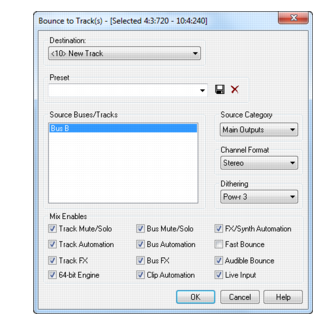The Track view Tracks > Bounce to Track(s) command lets you combine one or more audio tracks into a submix. A submix can be a mono track, a stereo track or several mono tracks that contain the mixture of the original tracks, preserving the volume, pan, and effects for each track. If you’re bouncing tracks that are routed to a surround bus (SONAR Producer only), you can bounce them to as many mono tracks as you have surround channels, by choosing the Split Mono option in the Channel Format field of the Bounce to Tracks dialog box, and also choosing a surround bus in the Source Category field. After their creation, the submix tracks are just like any other tracks—you can edit them, add effects, copy them to another project, etc. The original, unmixed audio tracks are not deleted, so you can archive them and recover them later, or continue using them as before.







Tip - Searching Documentation
Tip: To search for a specific topic, type your search query in the Search Cakewalk.com field at the top right of this page.
When the search results appear, click which product's documentation you would like to search to filter the search results further.
Note - Using Offline Help
Note: If you prefer to always use offline Help, go to Edit > Preferences > File > Advanced in your Cakewalk software and select Always Use Offline Help.
If you are not connected to the internet, your Cakewalk software will default to showing offline help until an internet connection becomes available.




